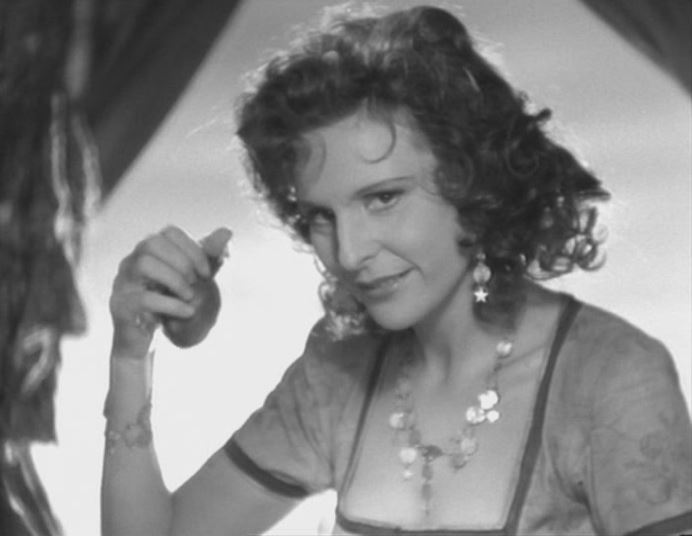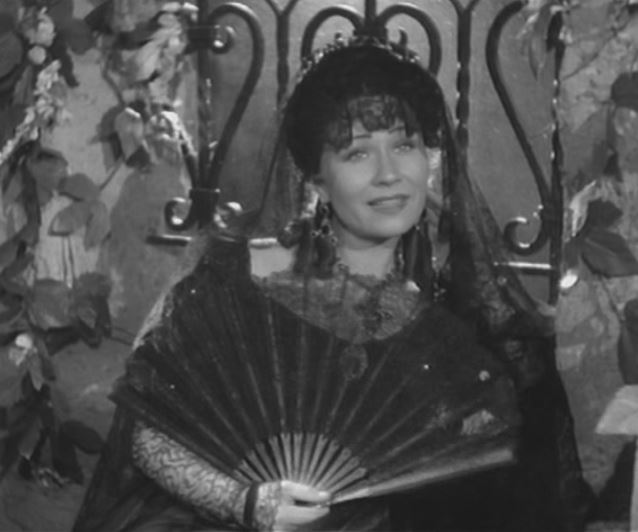

Ein herrischer Großgrundbesitzer verheiratet eine Zigeuner-Tänzerin an einen armen Berghirten. Er will sie als Geliebte behalten. In einem Messerkampfduell fällt der Schurke. Pathetisches Werk von und mit Leni Riefenstahl, dessen Dreharbeiten 1934 in Spanien begann und 1954 in Deutschland beendet wurden.
Für die Dreharbeiten zu Tiefland zwangsrekrutierte Leni Riefenstahl Roma aus dem sogenannten Zigeunerlager Maxglan und Sinti aus dem Zwangslager Berlin-Marzahn Rastplatz, um sie als ‘südlandische’ Komparsen und Kleindarsteller während der Dreharbeiten in Spanien einzusetzen. Nach den Dreharbeiten wurden die nicht mehr benötigten Darsteller in das ‘Zigeunerlager Auschwitz’ deportiert. Dieser Umstand sorgte nicht nur für zahlreiche juristische Auseinandersetzungen, sondern auch auch dafür, dass die Szenen mit zwangsverpflichteten Statisten aus der Uraufführung 1954 herausgeschnitten wurden.
Tiefland is a 1954 film that Leni Riefenstahl scripted, directed, acted in, and edited. It was produced by Leni Riefenstahl and Josef Plesner. It is based on the opera Tiefland (music by Eugen d'Albert, libretto by Rudolph Lothar) and the original play Terra baixa by Àngel Guimerà. Tiefland was the last full feature film of Riefenstahl as director and main actress. She started to develop the script in 1934, and shot the movie between 1940-44. The film, however, was not completed by the end of World War II and eventually was finalized and released on February 11, 1954. It was listed as the feature film with the longest production time by the Guinness Book of World Records. However, The Thief and the Cobbler surpasses this record by 31 years from 1964 to 1995.
Pedro, a shepherd, is sleeping in his Pyrenean mountain hut when his herd is attacked by a lone wolf. He awakens to defend his sheep, and strangles the wolf. In the Catalan lowlands (northeastern Spain), the construction of a canal is completed and diverts water from the farms and fields of the peasants to support the prized bulls of the landowner, Don Sebastian, marquis of Roccabruno. The request of the peasants for water is arrogantly rejected. He has, however, significant debts and needs money. The rich Amelia plans to marry him, but he offends her. Martha, a “beggar dancer”, has come to the village, and entertains the people. Sebastian sees her and takes her to his castle, enchanted by her beauty and grace. He keeps her as his mistress in a "golden cage". Martha pleads with him to listen to the plight of the peasants, but he rejects their request again. Seeing his arrogance and inhumanity she runs away. She collapses in exhaustion in the mountains where Pedro finds her and takes her to his hut. Sebastian's men locate her and return her to the castle. Sebastian in dire need to settle his finances conjures a plan. He will marry Amelia, but to keep Martha as a mistress, - he wants her married to somebody he can manipulate and control. Pedro is asked to marry her and installed in a mill under Sebastian’s control. For this Martha despises Pedro at first, but once she realizes that he married her out of love she responds. Sebastian arrives to be with his mistress. A fight ensues, and Pedro strangles him like he had done with the wolf. In the final scene Pedro and Martha walk up to the mountains.
Riefenstahl began working on the script in 1934, but shelved it when she became more involved with Nazi propaganda films. After the beginning of World War II, and disturbed by atrocities she witnessed, she had herself dispensed from shooting war documentaries. Using her influence as Hitler’s favorite film maker she managed her own production company, Riefenstahl Film, GmbH, independently of the control of Joseph Goebbels who oversaw cultural and propaganda activities. Financed by Hitler with money from the Nazi party and the government, she remained outside of Goebbels’ control. Goebbels eventually was not unhappy about it as the project ran into difficulties and cost overruns. Resuming her work on Tiefland, Riefenstahl started filming in Spain in 1940, but forced by war events soon shifted her work to the Alps, in Germany in the Karwendel and in Italy in the Rosengarten of the Dolomites, as well as the Babelsberg Studios in Berlin. Near Mittenwald, the Spanish village of Roccabruno was reconstructed. Although the German press anticipated the release of the movie in 1941, the production proved to be much more difficult and costly and outdoor shooting lasted until 1944. In 1941, Goebbels had complained about the "waste of money", and one year later called it a "rat’s nest of entanglements". Problems were compounded by Riefenstahl’s depression and other ailments, weather issues, accidents, and the difficulty of getting actors and staff organized during the war. Eventually, at a cost of about 8.5 million Reichsmark, Tiefland was the most expensive black-and-white movie produced in Nazi Germany. After the bombing of the Babelsberg studios in Berlin, the Barrandov Studios in Prague were used to further the work, and by the time the war came to the end, Riefenstahl was in the editing and synchronization process at Kitzbühl. Riefenstahl took the female lead role of Martha, a step that was not originally planned; however, she found no actress to her liking available at the time, and so she did it. Her last major role had been a decade before. She may have been attracted to play a dancer, as dancing was her original artistic calling. She later regretted the decision, as she looked much too old by her own account. "When I saw myself on the screen, I was embarrassed. There was no doubt about it, I was miscast." Critics seemed to agree: she was over forty, while her lover was played by the 23 year-old Franz Eichberger.
After the war, the film was confiscated and kept by French authorities for several years, but eventually returned to her. Four reels of film were missing when Riefenstahl received the film, notably the scenes shot in Spain. Despite efforts she failed to retrieve the missing footage. After its final editing, the movie was released in 1954.
In 1940, shooting of the movie was moved from Spain to Germany and Italy. In the Dolomites, people from the Sarntal were recruited as (paid) extras. However, for extras with a specific "Spanish look", Riefenstahl picked children and adults of Roma and Sinti background who were held in Nazi collection camps, so-called "Zigeunerlager". Fifty-one Roma and Sinti prisoners were chosen from the Maxglan-Leopoldskron camp (near Salzburg) for filming in the Alps in 1940, and, in 1942, at least 66 Roma and Sinti prisoners were taken from the Marzahn camp for scenes at Babelsberg. These extras are seen, for instance, in the dancing sequence in the tavern, and Sinti children run alongside Pedro when he comes down from the mountain to marry Martha.
In three denazification trials after the war, Riefenstahl was accused of Nazi collaboration and eventually termed a "fellow traveler"; however, none of the Sinti was asked to testify. The issue surfaced after the German magazine Revue published the use of these extras in 1949 and indicated that they were forced labor and sent later to Auschwitz where many of them were gassed upon arrival or shortly thereafter. While some of the surviving Sinti claimed that they were mistreated, others dissented. Riefenstahl claimed that she treated these extras well, and that she was not aware that they were going to be sent to Auschwitz. At one point she even insisted that, after the war, she had seen "all the gypsies" who had worked on the film.




